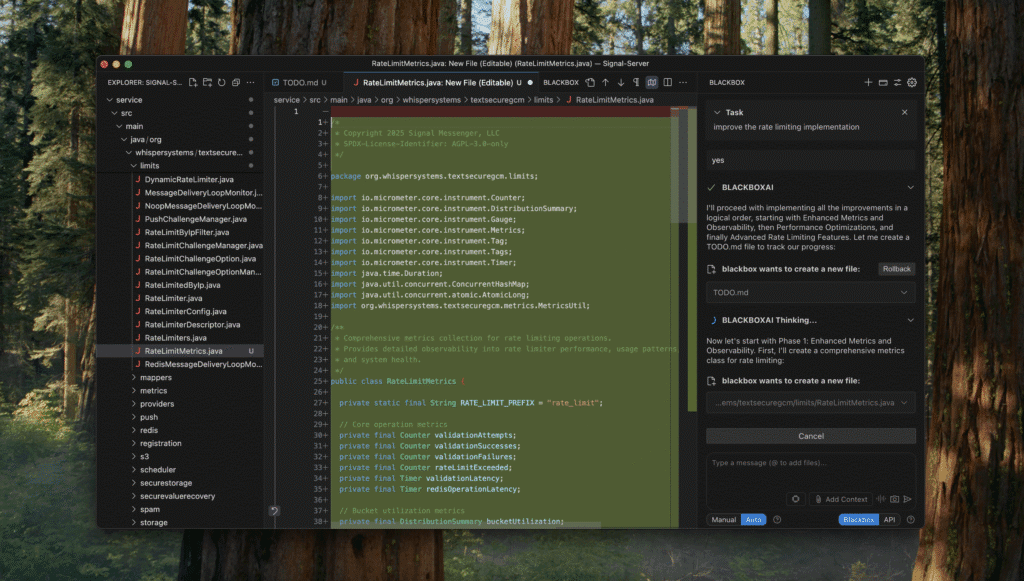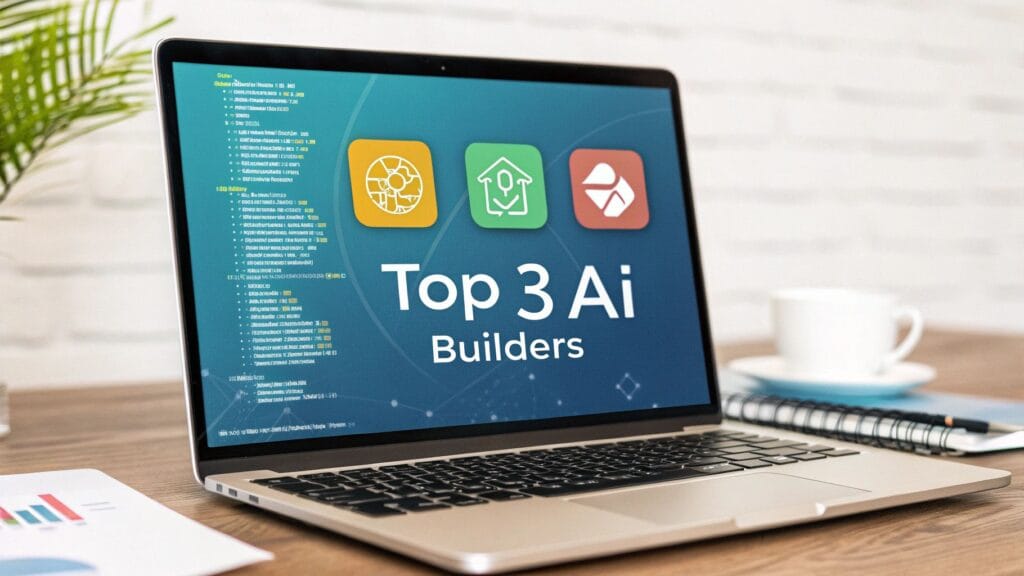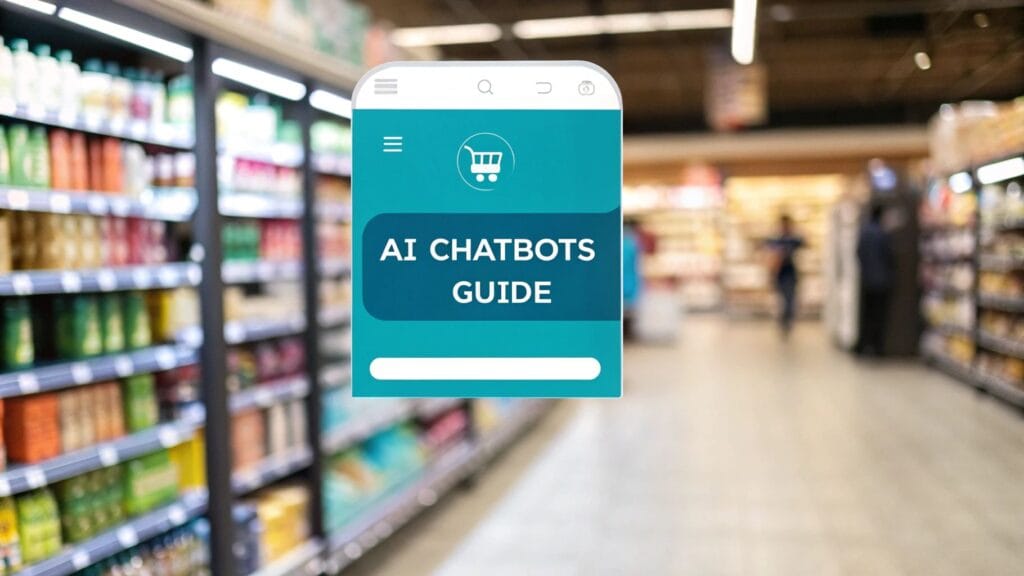This guide simplifies finding the top 3 AI app builder for your project. No-code platforms let you create powerful apps without programming skills. These tools help you build apps with smart features and launch your ideas quickly.
This article compares the leading AI app builders. We will look at their features, prices, and best uses. This information will help you choose the right tool for your business goals and technical skill.
1. Appy Pie
Appy Pie is a top choice for an AI app builder because it is simple and easy to use. It helps small businesses and entrepreneurs create mobile and web apps without code. The platform uses AI to automatically design app layouts and colors based on your brand. This feature speeds up the initial setup.
Key Features & User Experience
Appy Pie has an intuitive drag-and-drop interface. This makes it perfect for beginners. The user experience is direct and guides you through each step. Workflow automation is another key feature. It lets you create automated tasks like sending notifications or updating a database.
Pros:
- User-Friendly: Ideal for non-technical users.
- Affordable: Offers cost-effective plans starting around $16 per app/month.
- Feature-Rich: Includes a wide range of templates and integrations.
Cons:
- Limited Customization: Advanced developers may find the design options restrictive.
- Performance: Very complex apps can sometimes experience performance lags.
Website: https://www.appypie.com
2. Adalo
Adalo is another great AI app builder. It focuses on creating visually appealing mobile apps. The platform helps entrepreneurs build and launch apps on the Apple App Store and Google Play Store. You can do this without writing any code. This makes it a powerful tool for quick prototyping.
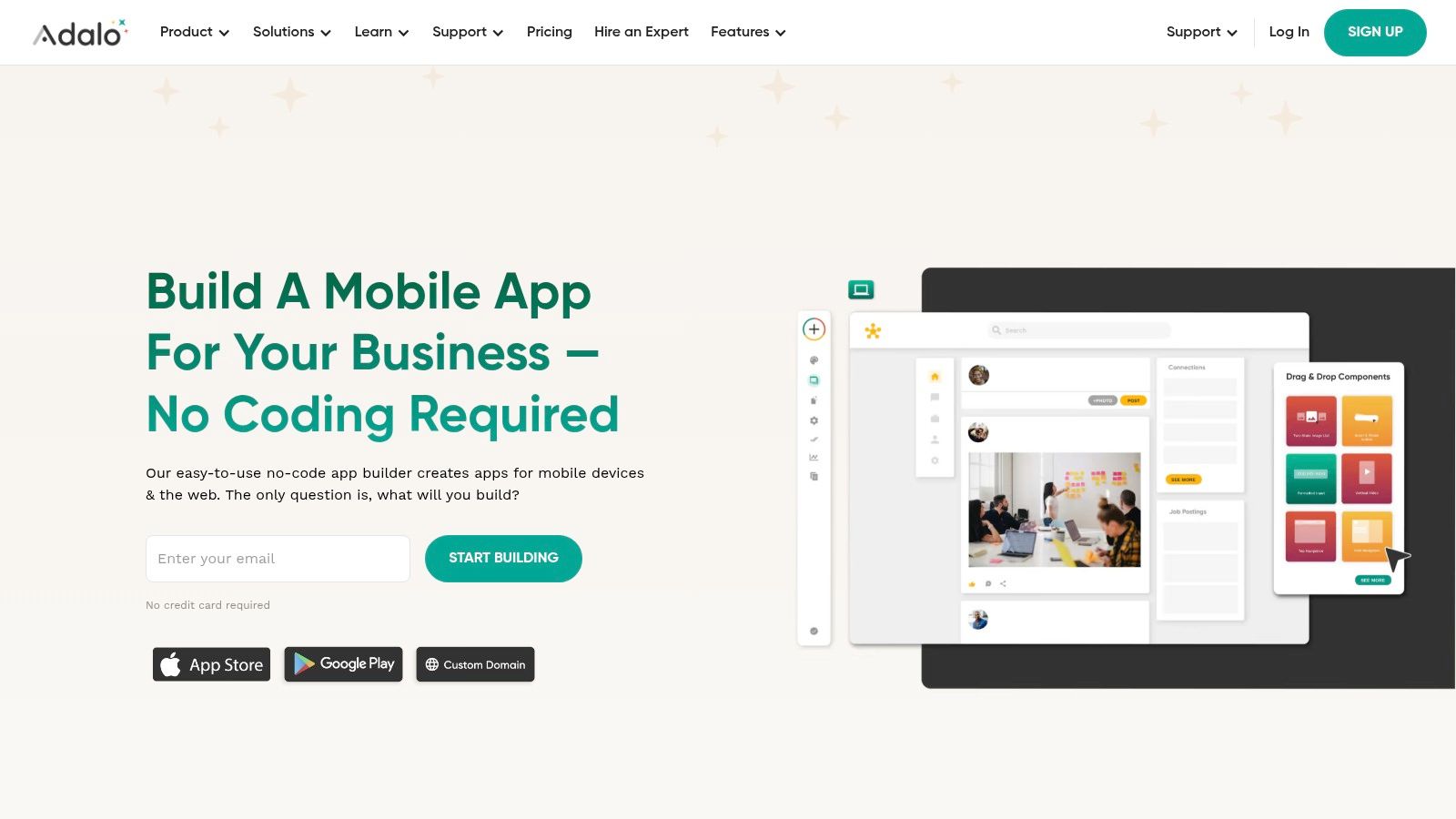
Key Features & User Experience
Adalo is known for its smooth drag-and-drop interface. It gives users total design freedom over the app's layout. The user experience is highly visual and focuses on connecting screens and actions. Key features include a built-in database, user authentication, and API integrations.
Pros:
- Intuitive Interface: Perfect for non-technical creators with a design-first approach.
- Rapid Deployment: Enables fast prototyping and launching of mobile apps.
- Active Community: Offers robust support through forums and tutorials.
Cons:
- Limited Backend: Complex backend logic may require external services.
- Performance Scaling: Highly complex apps can encounter performance limitations.
Website: https://www.adalo.com
3. Softr
Softr completes our list of the top 3 AI app builder platforms. It is an excellent choice for turning data into web applications. The platform allows you to transform Airtable or Google Sheets into client portals or internal tools. Softr uses AI-assisted blocks to generate a user-friendly front-end from your data.
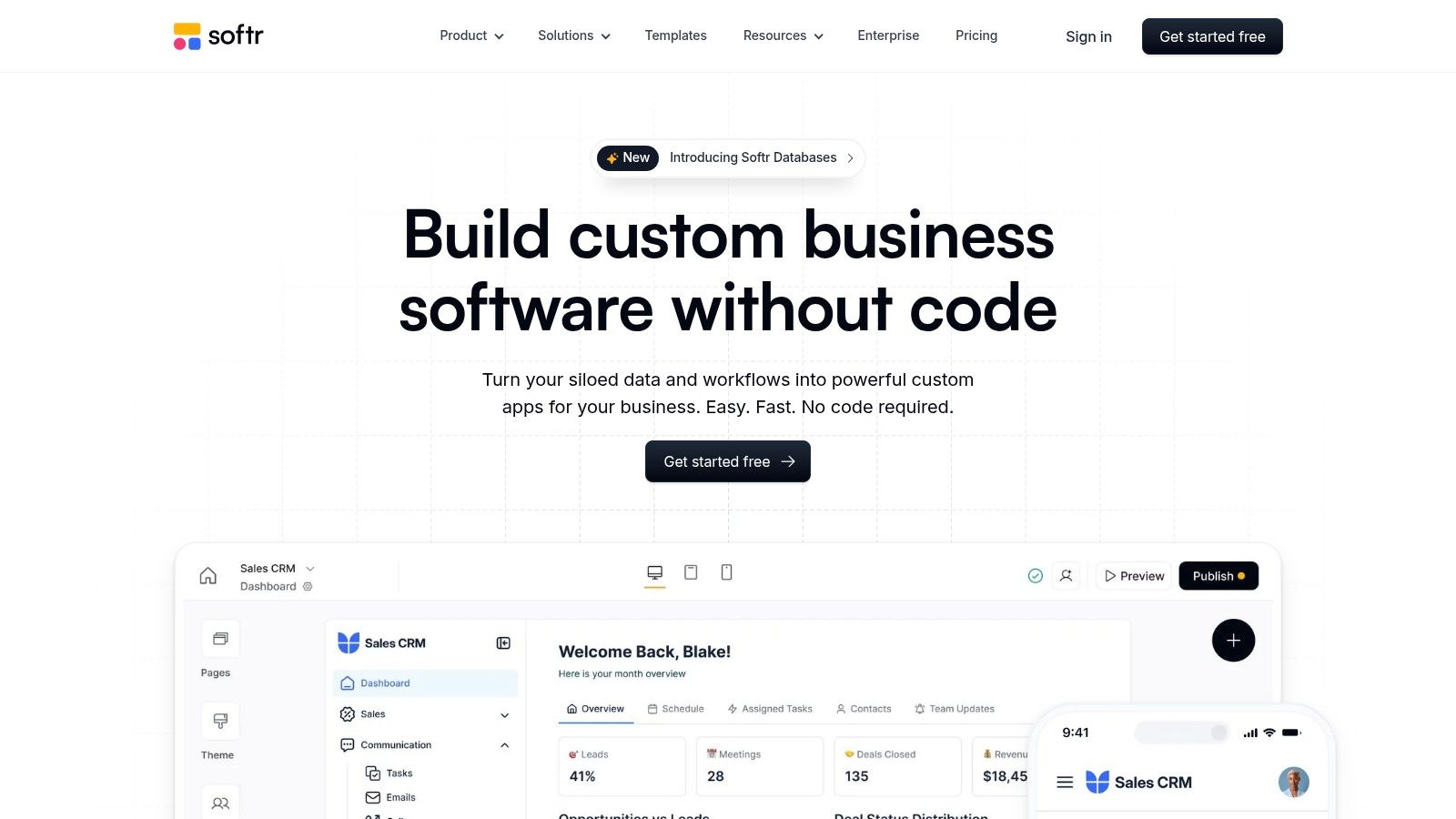
Key Features & User Experience
Softr’s user experience is simple and intuitive. It uses pre-built, customizable blocks that you arrange to build your interface. This process makes development very fast. Key features include seamless integration with Airtable and Google Sheets. It also has user authentication and built-in SEO tools.
Pros:
- Quick Setup: Go from a spreadsheet to a live app in minutes.
- No Coding Required: Entirely visual and block-based, ideal for non-developers.
- Data-Centric: Perfect for building client portals, internal tools, or directories.
Cons:
- Design Limitations: Less flexible than traditional coding or more advanced builders.
- Data Dependency: The app’s functionality is tied to Airtable/Google Sheets limitations.
Website: https://www.softr.io
4. Bubble
Bubble is a powerful no-code platform for building complex web applications with AI. It gives users full control over design and logic. Bubble allows you to build with AI by integrating services like OpenAI or Google AI through APIs. It is a favorite for startups that need custom products.
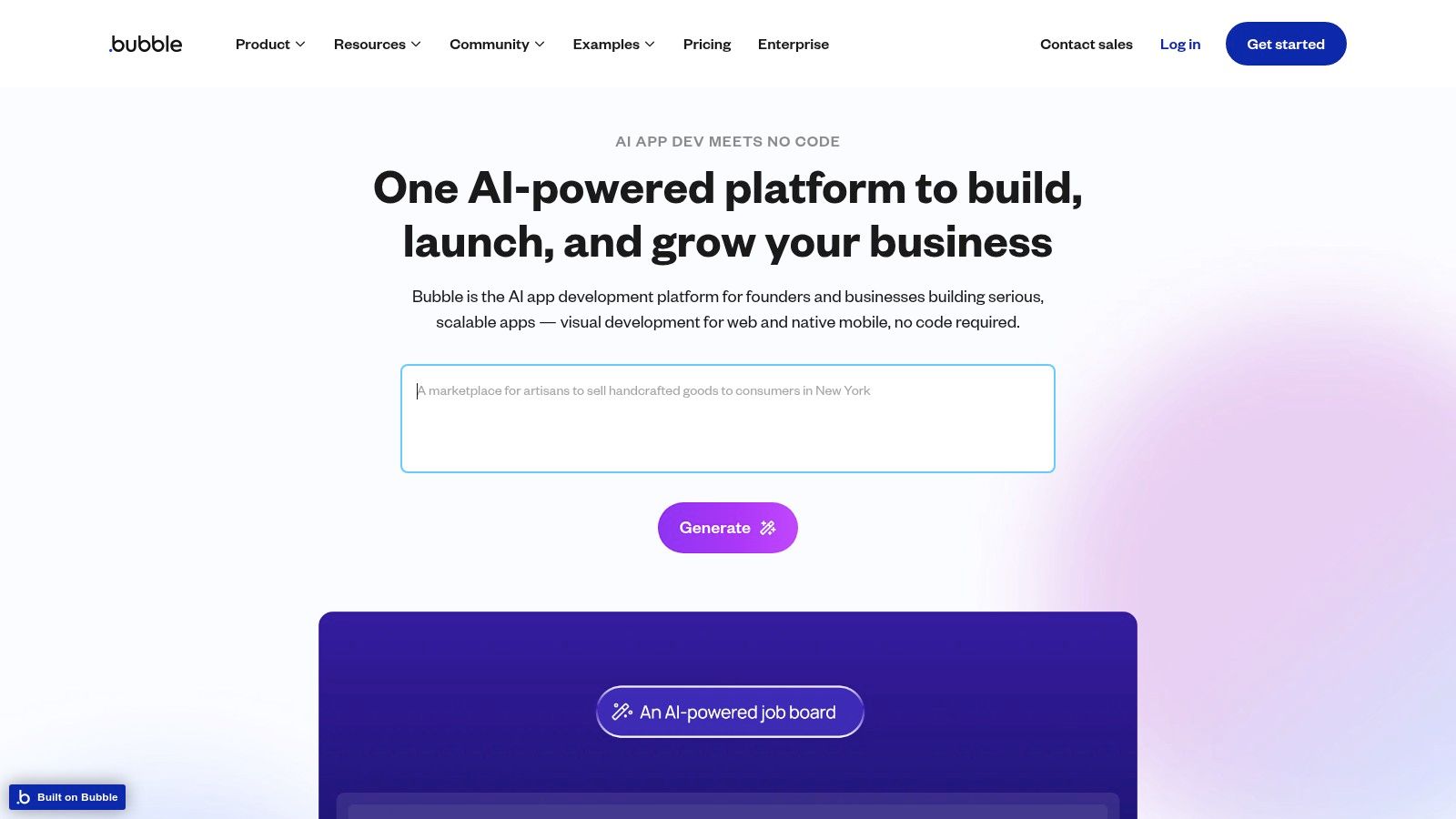
Key Features & User Experience
Bubble has a visual drag-and-drop editor for precise control over page elements. Its real strength is its customizable backend workflows and database. The platform has a steeper learning curve but lets you build sophisticated applications. You can learn more about no-code platforms to see how it compares.
Pros:
- Highly Customizable: Offers near-limitless freedom in design and functionality.
- Scalable: Suitable for complex SaaS platforms, marketplaces, and internal tools.
- Strong Community: Extensive documentation, tutorials, and a very active user forum.
Cons:
- Steeper Learning Curve: Requires more time to master compared to simpler tools.
- Performance Tuning: Optimizing complex apps can demand technical understanding.
Website: https://bubble.io
5. AppSheet by Google
AppSheet by Google is a strong choice for organizations in the Google ecosystem. It turns data from sources like Google Sheets and Excel into rich applications without code. AppSheet's AI and machine learning automate processes. This makes it great for building internal tools for inventory or field reports. Reading about digital transformation best practices can offer useful context.
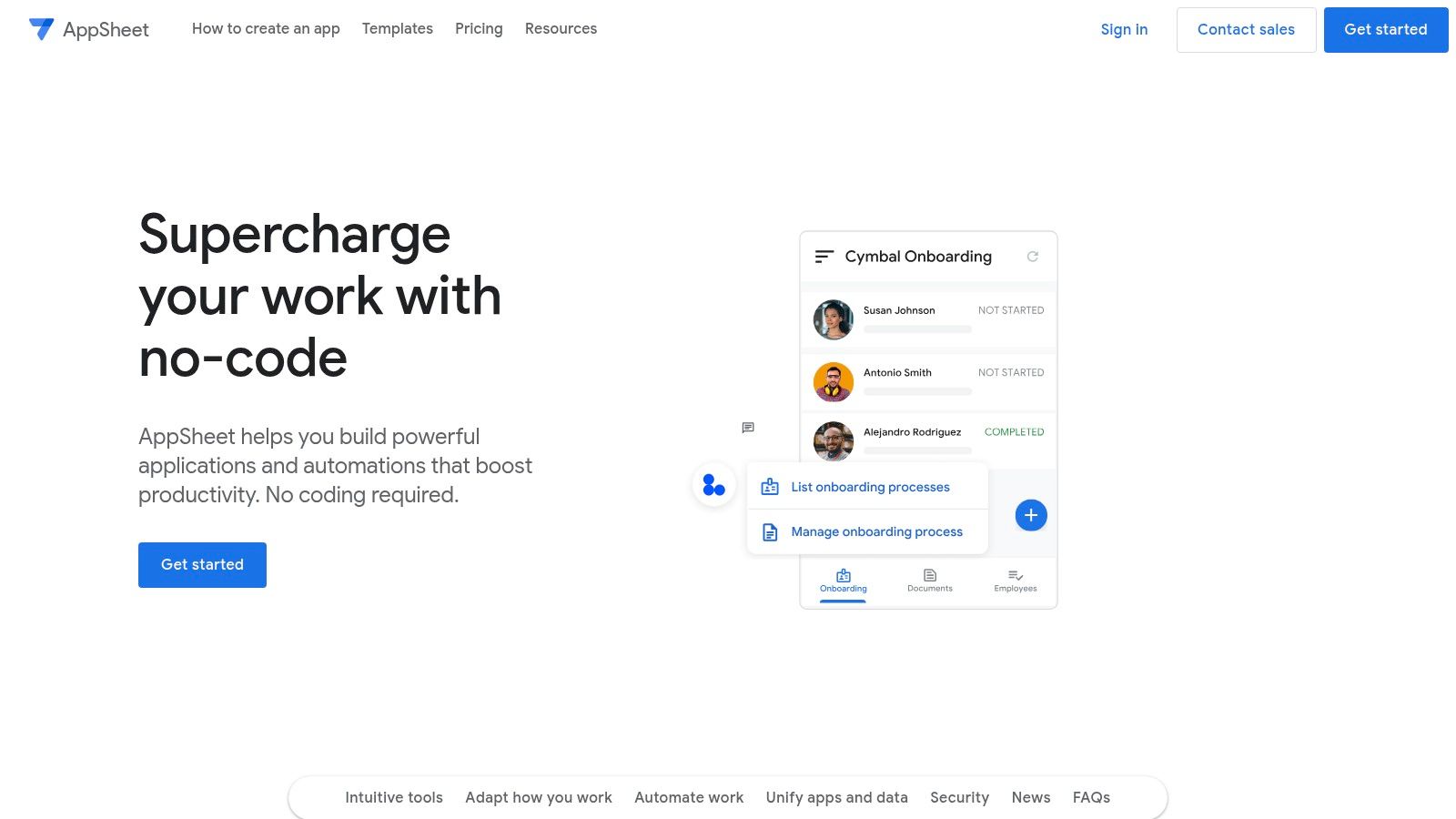
Key Features & User Experience
AppSheet's user experience focuses on using existing data. The platform's AI can predict the type of app you want based on your data structure. Key features include workflow automation, offline functionality, and multi-platform deployment. It prioritizes function over design.
Pros:
- Seamless Integration: Works perfectly with Google Workspace and other data services.
- Powerful Automation: Strong AI capabilities for creating intelligent, automated workflows.
- Enterprise-Ready: Suitable for complex business and data-centric applications.
Cons:
- Limited Customization: Design and UI options are more functional than creative.
- Pricing: Can become costly for larger teams or extensive enterprise use.
Website: https://www.appsheet.com
6. Zoho Creator
Zoho Creator is a low-code platform for building complex, data-driven applications. It handles detailed business logic, automation, and analytics. Zoho Creator connects with other Zoho tools like CRM and Books. This creates a unified system for your business operations.
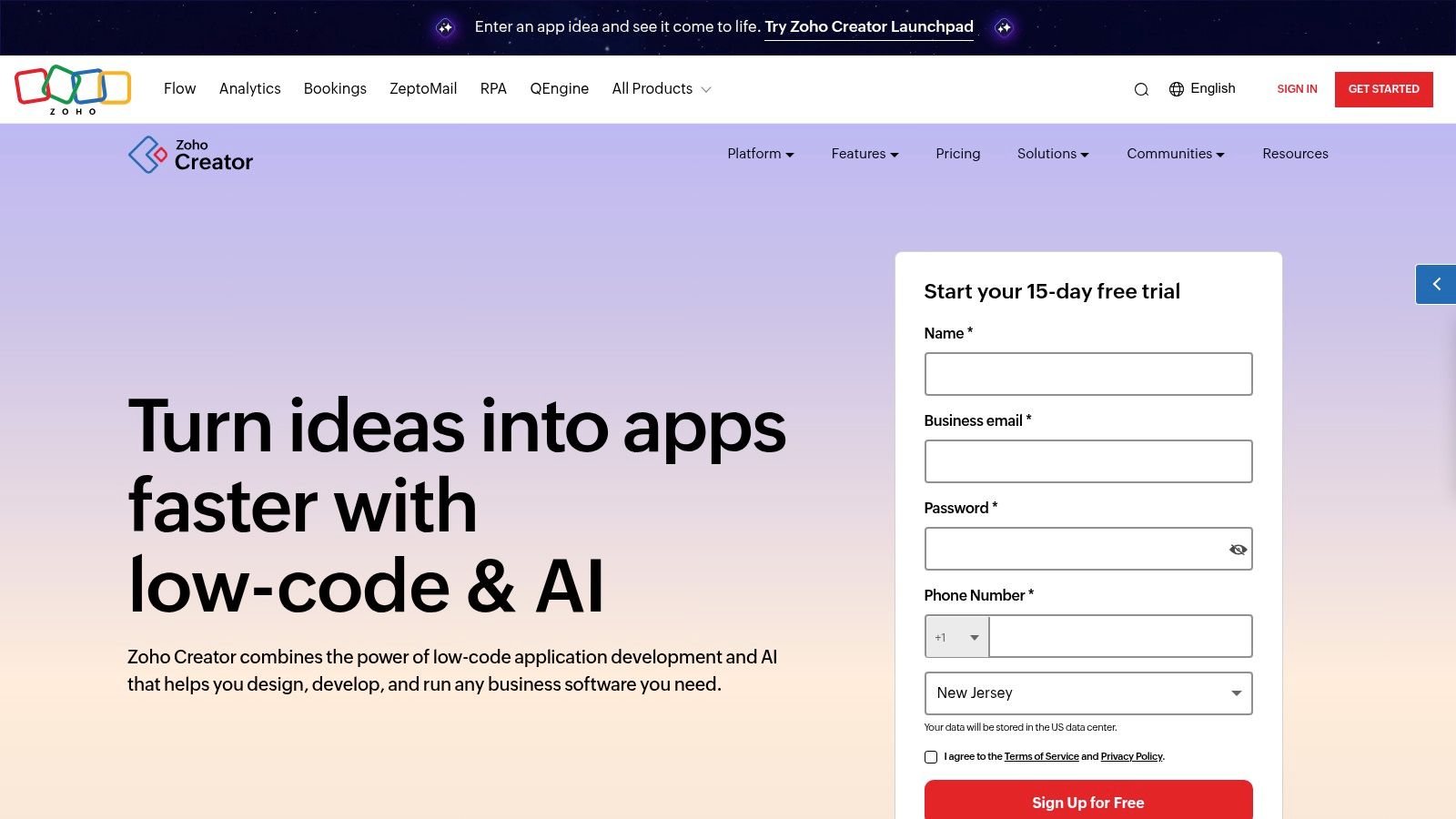
Key Features & User Experience
Zoho Creator has a drag-and-drop interface and scripting options. Its AI integration allows for features like predictive analytics. The platform supports multi-platform deployment. You can launch your app on web, iOS, and Android from one codebase.
Pros:
- Comprehensive Feature Set: Ideal for building powerful, scalable business applications.
- Zoho Ecosystem: Excellent integration with other Zoho business products.
- Strong Automation: Advanced workflow automation capabilities for complex processes.
Cons:
- Steeper Learning Curve: Can be more challenging for complete beginners.
- Higher Cost: Pricing can increase significantly for advanced features and more users.
Website: https://www.zoho.com/creator
7. Glide
Glide turns Google Sheets into powerful mobile apps very quickly. It is designed for users who need functional apps from their data without coding. Glide synchronizes with Google Sheets in real-time. This means your app updates instantly when your data changes.
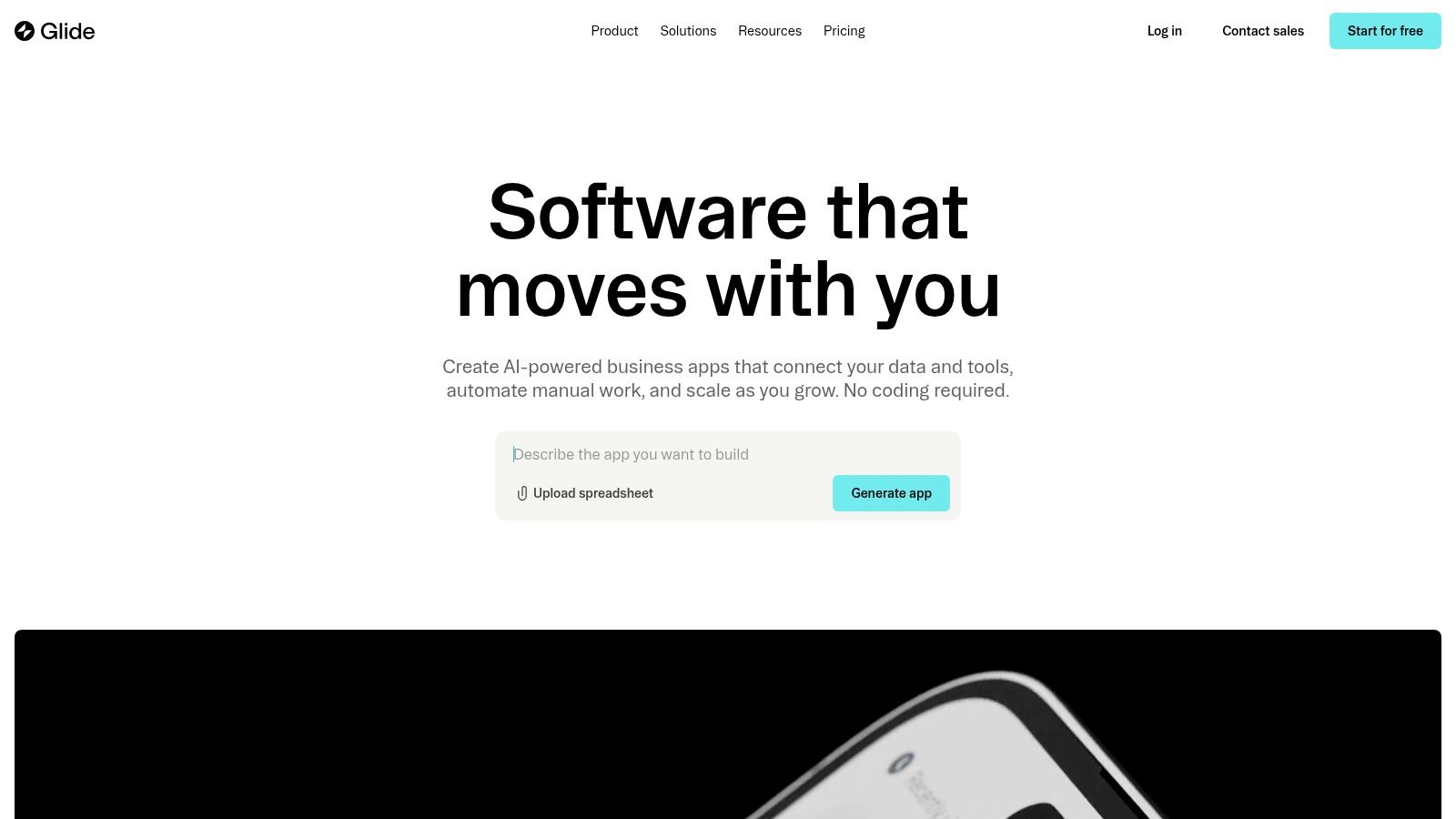
Key Features & User Experience
Glide offers a very smooth user experience. You can build a working app in minutes. Its interface is clean and visual, with pre-built templates and layouts. The platform also offers offline functionality. This is a big benefit for teams in areas with poor connectivity.
Pros:
- Easy to Use: Perfect for non-developers and spreadsheet users.
- Rapid App Development: Go from spreadsheet to app in minutes.
- No Coding Required: Entirely visual build process.
Cons:
- Limited Customization: Design and functionality are somewhat constrained.
- Dependent on Google Sheets: Its core strength is also its main limitation.
Website: https://www.glideapps.com
8. Thunkable
Thunkable is a no-code platform for building native iOS and Android apps. It allows users to create more complex applications with its drag-and-drop interface. The platform supports API integrations and real-time testing. It is a great choice for beginners and educators.
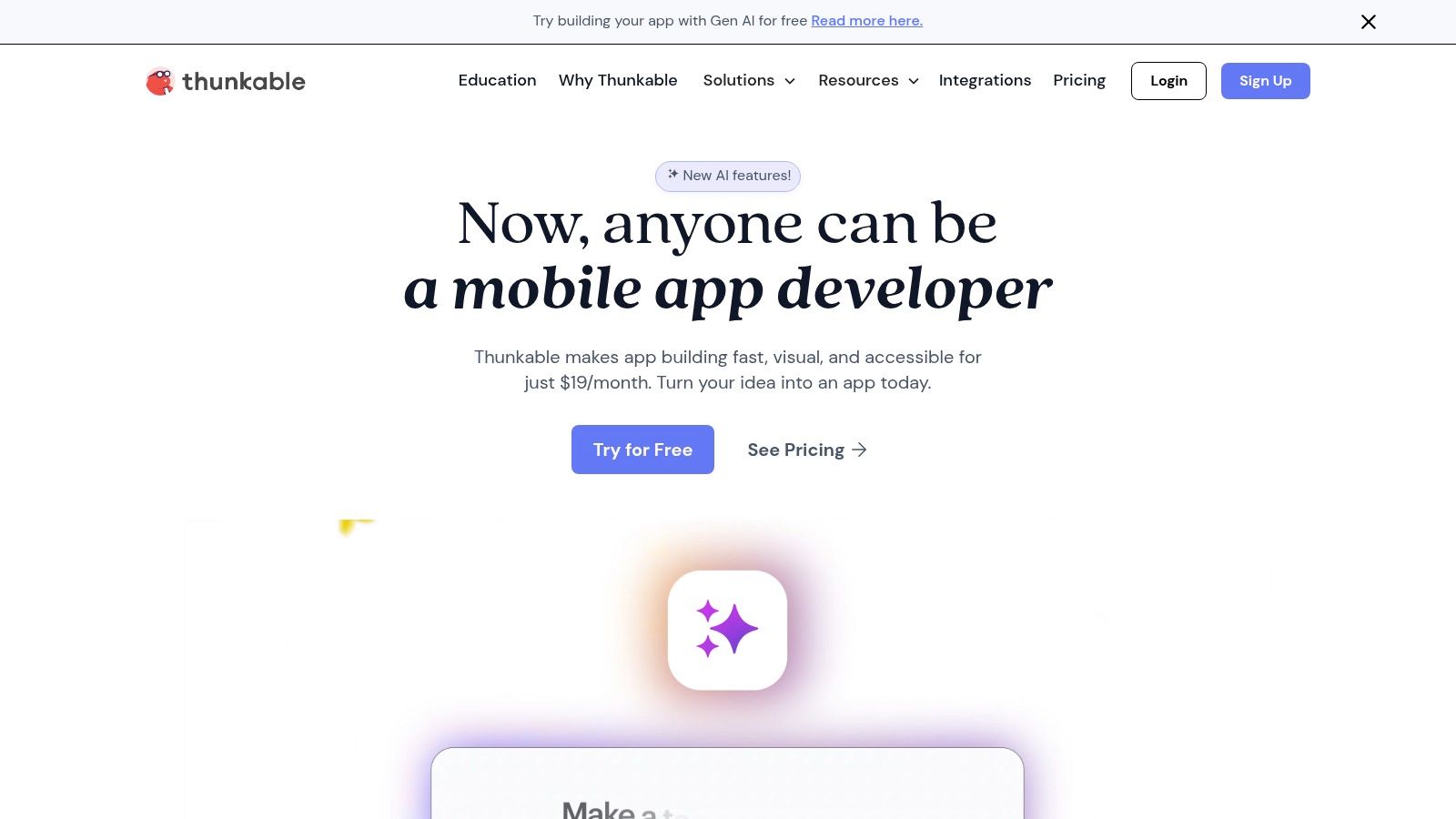
Key Features & User Experience
The user experience on Thunkable uses visual block-based programming. This simplifies adding logic to an app. Users can integrate various APIs to connect their app with external services. Small businesses can discover the potential of automation for small business with tools like this.
Pros:
- Native App Support: Builds true iOS and Android applications.
- Complex Functionality: Supports API integrations and advanced logic.
- Active Community: Strong community support and extensive resources.
Cons:
- Design Limitations: Customization options can be restrictive for designers.
- Performance: Complex apps may sometimes face performance issues.
Website: https://www.thunkable.com
9. Builder.ai
Builder.ai uses a mix of AI automation and human experts to deliver custom apps. This hybrid model makes it different from pure no-code platforms. The platform’s AI, Natasha, assembles pre-built features. Human developers then refine the app to meet specific needs.
Key Features & User Experience
Builder.ai uses a conversational interface to define your app idea. It then gives you a fixed price and timeline. The platform offers a library of customizable features. It also handles development, maintenance, and cloud hosting as a fully managed service.
Pros:
- Tailored Solutions: Creates custom apps that fit precise business needs.
- Rapid Development: Significantly faster than traditional development cycles.
- Suitable for Complex Apps: Can handle sophisticated functionalities and integrations.
Cons:
- Higher Cost: More expensive than standard no-code builders due to customization.
- Less Direct Control: Users have less hands-on control over the development process.
Website: https://www.builder.ai
10. Hostinger Horizons
Hostinger Horizons is a platform for rapid web application development. It combines no-code AI tools with hosting and domain services. This creates an all-in-one environment. Users can build and launch their apps from a single dashboard.
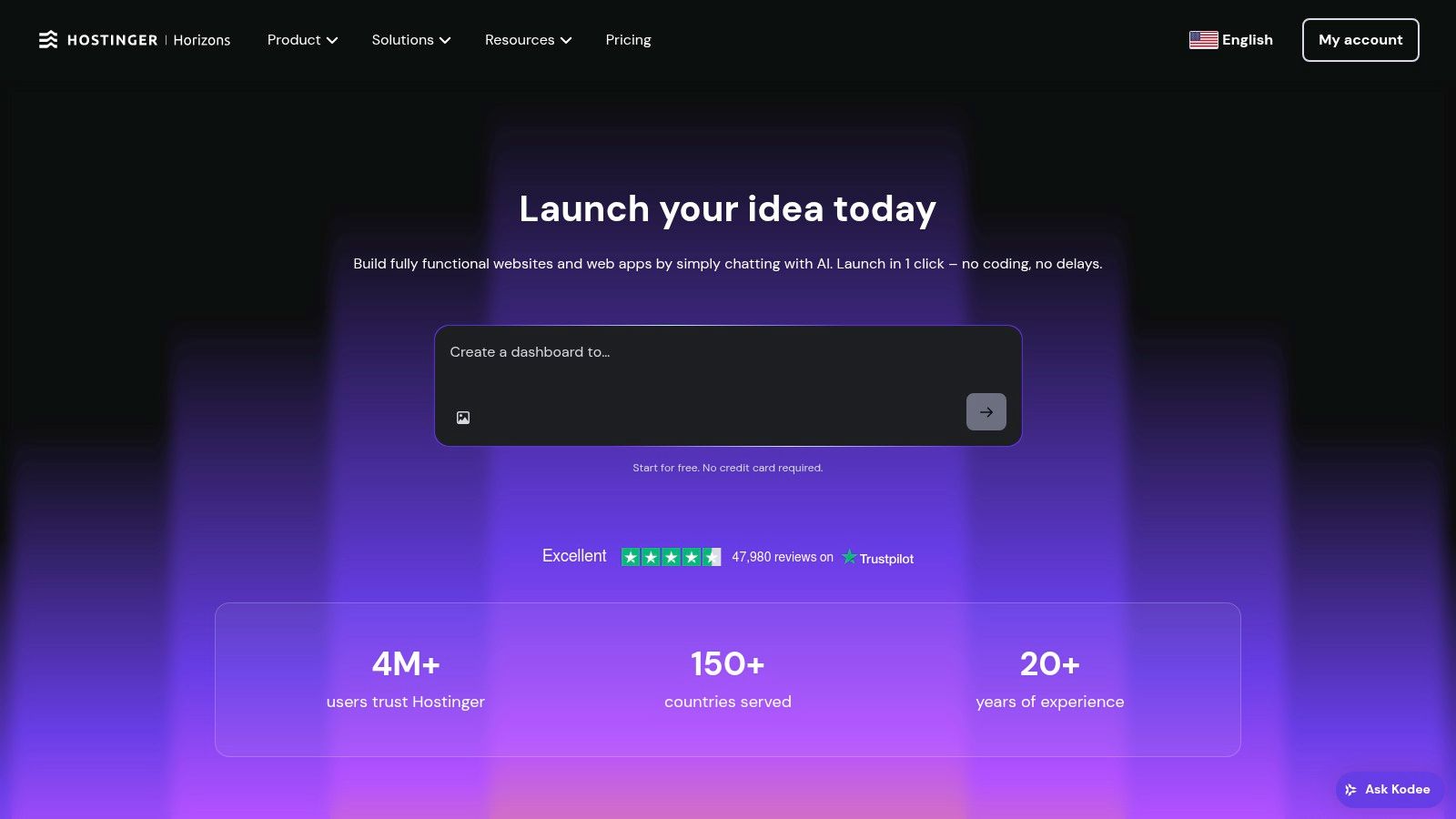
Key Features & User Experience
Hostinger Horizons has an AI-powered builder and a real-time editor. It supports voice and image inputs for creating content. The platform's built-in multilingual support helps you create global applications easily.
Pros:
- Rapid app development: Go from idea to a live app quickly.
- Integrated hosting and domain services: Simplifies setup and management.
- User-friendly interface: Easy for beginners to navigate and use.
Cons:
- Limited advanced customization: May not suit complex, highly specific project needs.
- Some features still under development: The platform is still evolving.
Website: https://www.hostinger.com/horizons
11. Microsoft Power Apps
Microsoft Power Apps is a strong low-code platform for business applications. It is ideal for organizations using the Microsoft ecosystem. Its AI Builder component lets users add AI capabilities like prediction models into their apps. This helps automate and improve business processes.
Key Features & User Experience
Power Apps is designed for professional use. It integrates with Microsoft 365, Dynamics 365, and Azure. This allows for powerful workflow automation and data connection. The user experience is more technical but provides great control for building enterprise-grade solutions.
Pros:
- Comprehensive Feature Set: Ideal for creating complex business applications.
- Seamless Integration: Works perfectly with other Microsoft services.
- Scalable: Suitable for small projects and large enterprise deployments.
Cons:
- Steeper Learning Curve: May be challenging for complete beginners.
- Pricing: Can become costly for larger teams or advanced features.
Website: https://powerapps.microsoft.com
12. FlutterFlow
FlutterFlow uses Google's Flutter framework to build high-performance apps. It combines no-code simplicity with developer-level power. Its visual builder turns drag-and-drop actions into clean Dart code. This low-code environment speeds up development for everyone.
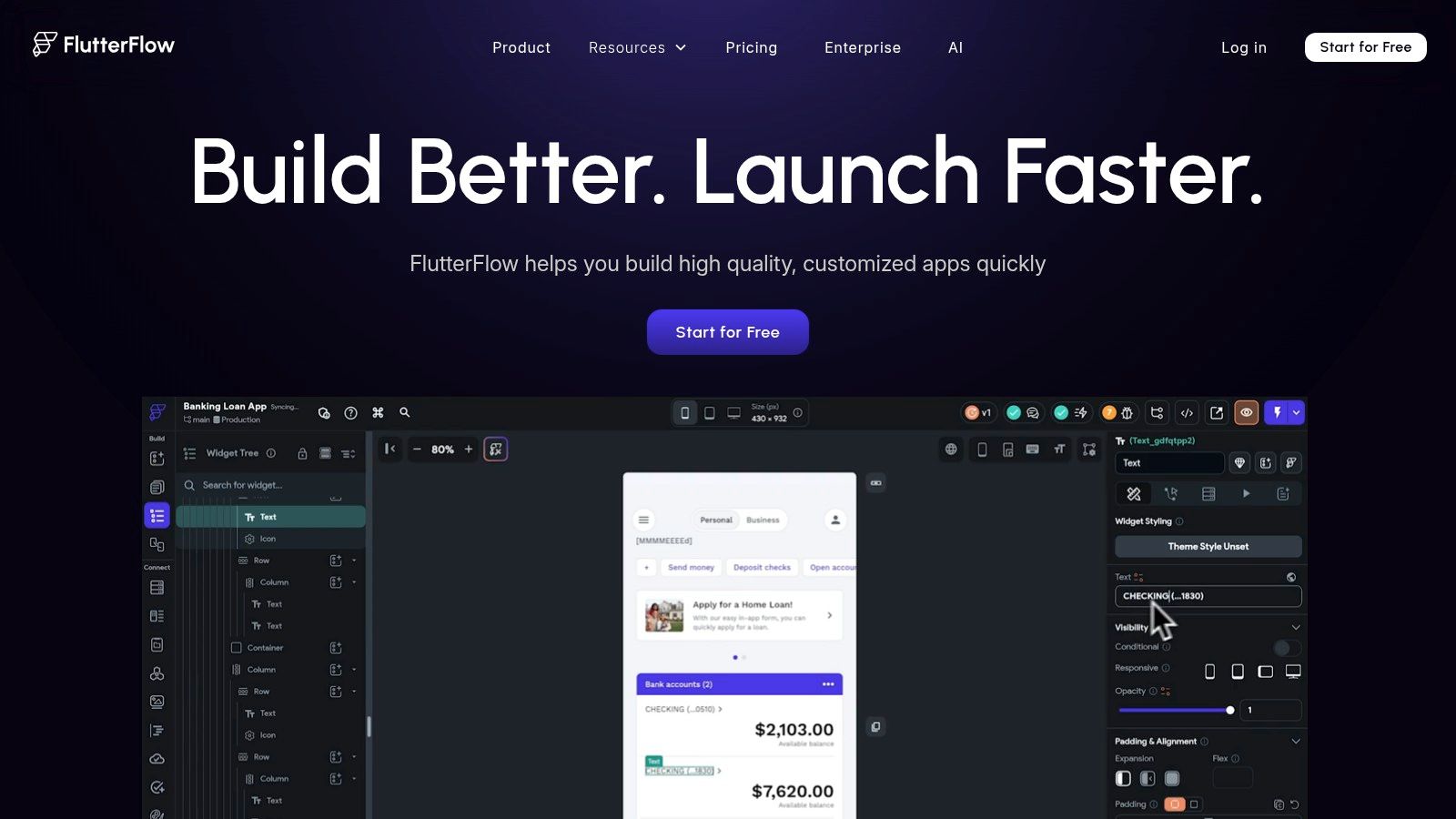
Key Features & User Experience
FlutterFlow integrates seamlessly with Firebase for backend services. The user experience is highly visual and intuitive. It allows real-time testing directly within the builder. Users can build complex functions that are not possible with other no-code tools.
Pros:
- Powerful Functionality: Supports complex logic and native features.
- Cross-Platform: Build and deploy to iOS, Android, and web from a single project.
- Code Export: Provides access to the underlying clean code for full control.
Cons:
- Steeper Learning Curve: More complex than purely no-code alternatives.
- Best with Firebase: Heavily optimized for Firebase, which may not suit all backend needs.
Website: https://flutterflow.io
Top 12 AI App Builders Feature Comparison
| Platform | Core Features | User Experience | Target Audience | Unique Selling Points | Price Points |
|---|---|---|---|---|---|
| Appy Pie | Drag-and-drop builder, AI design, workflow automation | Beginner-friendly, affordable | Small businesses, individuals | AI-powered design, multilingual support | Low-cost plans |
| Adalo | Drag-and-drop, real-time updates, external DB integration | Intuitive, rapid prototyping | Individuals, small businesses | Responsive design, active community | Affordable |
| Softr | Airtable/Google Sheets integration, templates, authentication | Quick setup, no coding | Client portals, internal tools | SEO tools, pre-built blocks | Moderate |
| Bubble | Visual editor, backend, API integration | Highly customizable, complex apps | Advanced users, startups | Full customization, scalability | Moderate to high |
| AppSheet by Google | Google Workspace integration, AI, workflow automation | Enterprise-grade, powerful AI | Enterprises | AI/ML features, multi-platform | Higher pricing |
| Zoho Creator | Drag-and-drop, AI integration, automation | Feature-rich, complex apps | Businesses, Zoho users | Zoho ecosystem integration | Mid to high |
| Glide | Google Sheets integration, real-time sync | Easy to use, fast development | Beginners, simple apps | Offline mode, templates | Low to moderate |
| Thunkable | Drag-and-drop, native iOS/Android support | User-friendly, supports complexity | Educators, individuals | Native app building, community support | Moderate |
| Builder.ai | AI-assisted development, scalable architecture | Tailored solutions, fast process | Businesses needing custom apps | Ongoing support | Higher cost |
| Hostinger Horizons | AI-powered no-code, built-in hosting/domain | User-friendly, rapid development | Beginners, small businesses | Voice/image inputs, hosting included | Affordable to moderate |
| Microsoft Power Apps | Microsoft 365/Azure integration, AI, workflow automation | Comprehensive, steep learning curve | Enterprises, advanced users | Seamless Microsoft ecosystem integration | High |
| FlutterFlow | Drag-and-drop, Firebase integration, cross-platform | User-friendly, complex functionality | Developers, non-developers | Cross-platform support | Moderate |
Final Thoughts
Your choice from the top 3 AI app builder options depends on your needs. The right tool aligns with your project, skills, and goals. First, define your app's main function. Then, assess your technical comfort level. A simple platform is best for beginners, while advanced users may want more control. Finally, consider the price and how the platform can grow with your app. A good choice now will save you time and money later.
Ready to move beyond templates and build a truly custom AI solution? If these builders don't quite fit your unique vision, creavoid can help. We specialize in developing bespoke AI applications and platforms, turning your complex ideas into powerful, market-ready realities. Visit creavoid to see how our expert development services can bring your project to life.
